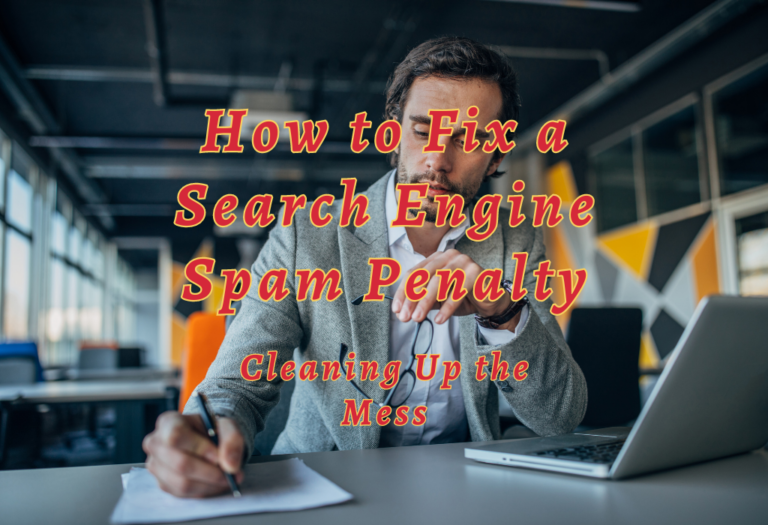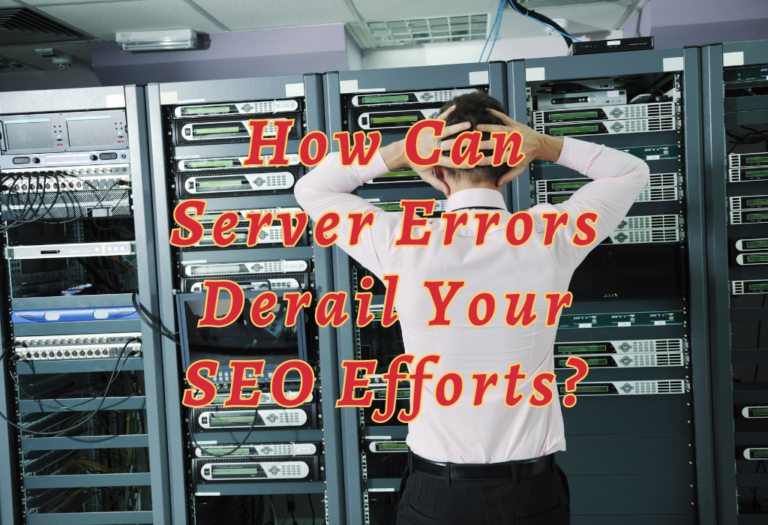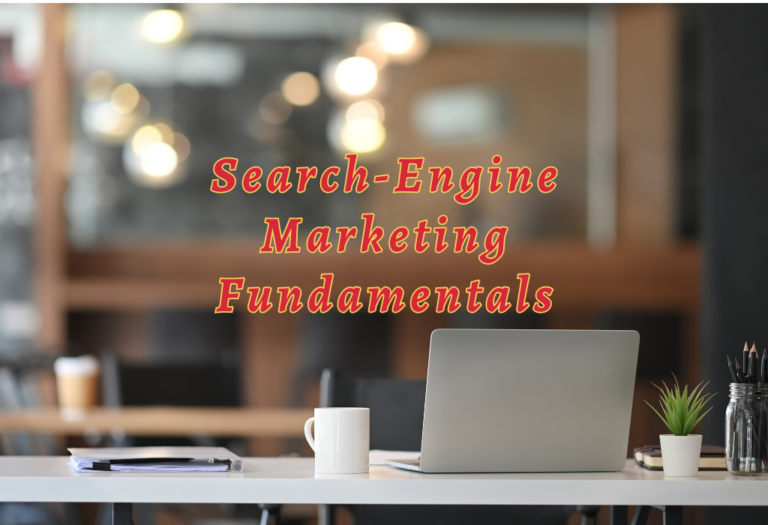What’s the Difference Between SEO and SEM? A Comprehensive Guide
Search engine optimization (SEO) and marketing (SEM) often need to be clarified. Understanding the differences between SEO and SEM is essential, as they each have unique benefits regarding digital marketing strategies. So what’s the difference between SEO and SEM?
In this blog post, we will explore how long it takes to see results from both methods, what features set them apart from one another, which has a better return on investment, when it is best to combine them or use either one alone – all to help you make informed decisions about your online presence!
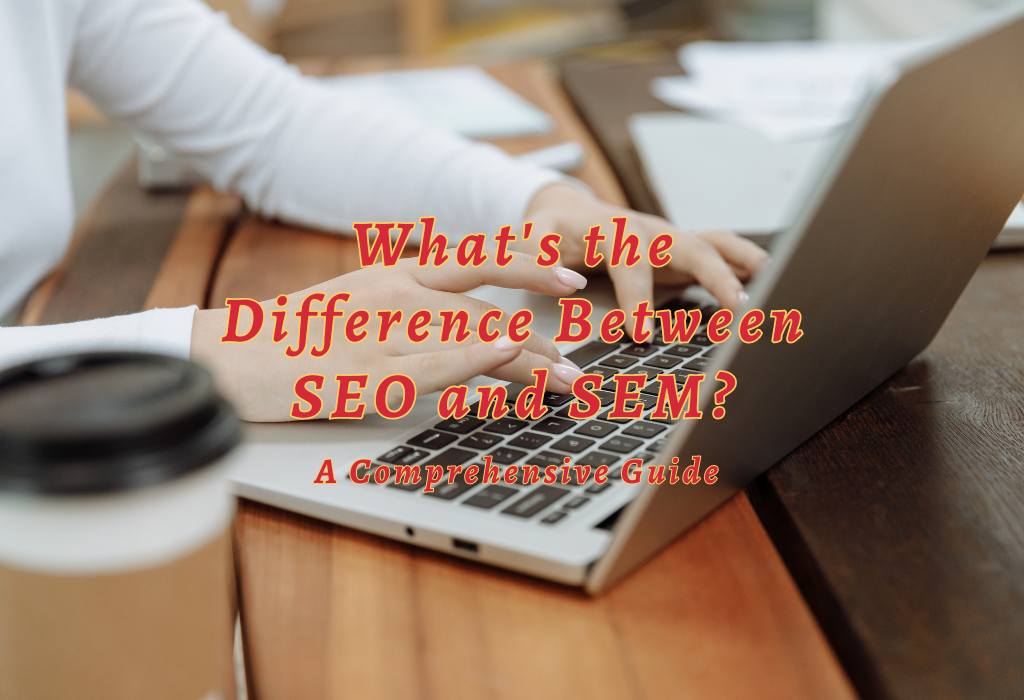
Difference Between SEO and SEM
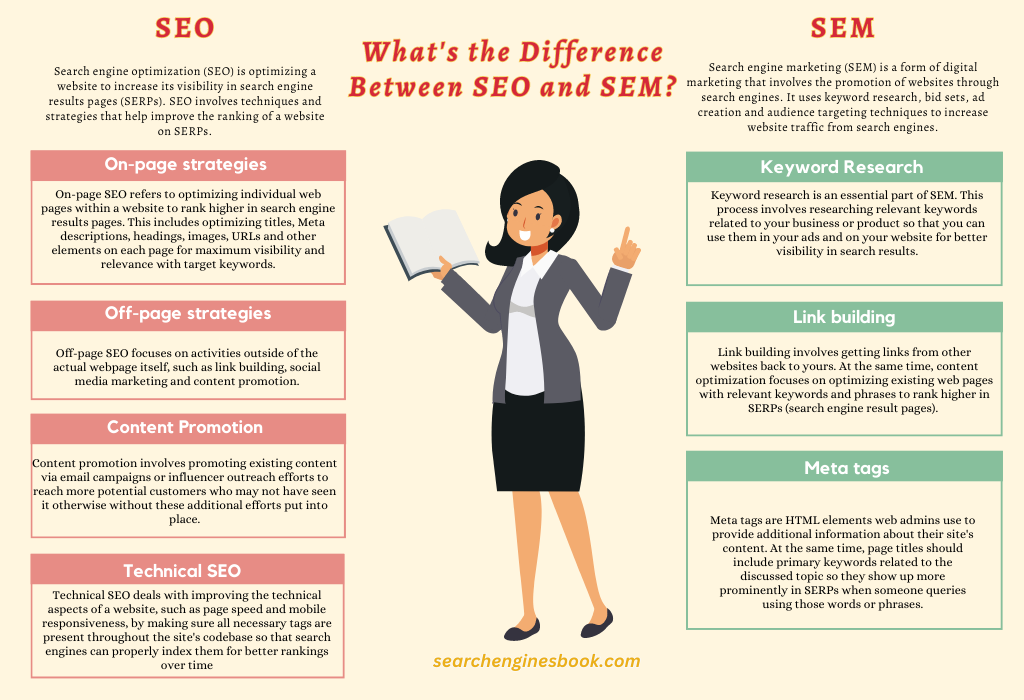
What is SEO and How Does it Work?
Search engine optimization (SEO) is optimizing a website to increase its visibility in search engine results pages (SERPs). SEO involves techniques and strategies that help improve the ranking of a website on SERPs.
Keyword research is an integral part of SEO. It involves researching and analyzing relevant keywords when searching for your business or product information.
This helps you identify which words are most likely to be used by potential customers so that you can optimize your content accordingly.
On-page strategies
On-page SEO refers to optimizing individual web pages within a website to rank higher in search engine results pages. This includes optimizing titles, Meta descriptions, headings, images, URLs and other elements on each page for maximum visibility and relevance with target keywords.
Off-page strategies
Off-page SEO focuses on activities outside of the actual webpage itself, such as link building, social media marketing and content promotion. Link building involves creating links from external websites back to yours to build authority and trustworthiness with search engines like Google or Bing.
Content Promotion
Social media marketing helps promote your content across various platforms while also helping drive traffic back to your site through shares or likes from users who find it interesting or valuable. Content promotion involves promoting existing content via email campaigns or influencer outreach efforts to reach more potential customers who may not have seen it otherwise without these additional efforts put into place.
Technical SEO
Technical SEO deals with improving the technical aspects of a website, such as page speed and mobile responsiveness, by making sure all necessary tags are present throughout the site’s codebase so that search engines can properly index them for better rankings over time if done correctly according to their guidelines set forth by each respective platform’s algorithm updates released periodically throughout any given year(s).
SEO is crucial for optimizing web content and ensuring it reaches the right people. Now, let’s look at SEM and how it works to help you maximize your online presence.
Key Takeaway: Search engine optimization (SEO) is essential for increasing visibility in search engine results pages. It involves keyword research, on-page and off-page optimization, and technical SEO. By following best practices and understanding the differences between each type of SEO, businesses can improve their ranking in SERPs and reach more potential customers.
What is SEM and How Does it Work?
Search engine marketing (SEM) is a form of digital marketing that involves the promotion of websites through search engines. It uses keyword research, bid sets, ad creation and audience targeting techniques to increase website traffic from search engines.
Keyword Research
Keyword research is an essential part of SEM. This process involves researching relevant keywords related to your business or product so that you can use them in your ads and on your website for better visibility in search results.
Bid setting helps determine how much you are willing to pay for each click on an advertisement. Ad creation involves creating targeted keywords appearing when someone searches for those terms.
Audience targeting allows you to target specific groups of people who may be more likely to buy your products or services based on their interests and demographics.
SEM Tactics
SEM also includes other strategies such as link building, content optimization, meta tags and page titles optimization, which help improve the ranking of a website in organic search results by making it easier for search engine crawlers to find it online.
Link building
Link building involves getting links from other websites back to yours. At the same time, content optimization focuses on optimizing existing web pages with relevant keywords and phrases to rank higher in SERPs (search engine result pages).
Meta tags
Meta tags are HTML elements web admins use to provide additional information about their site’s content. At the same time, page titles should include primary keywords related to the discussed topic so they show up more prominently in SERPs when someone queries using those words or phrases.
Key Takeaway: SEM is an effective way to increase online visibility and drive website traffic. It involves techniques such as keyword research, bid sets, ad creation, audience targeting, link building, content optimization, meta tags and page titles optimization. When appropriately implemented with ongoing monitoring and analysis of these strategies, businesses can maximize their return on investment from SEM over time.
SEO vs SEM: How Long It Takes to See Results
When it comes to SEO and SEM, one of the most common questions is how long it takes to see results. The answer depends on various factors, including budget size, competition level, keyword difficulty and more.
SEO campaigns
Suppose you’re running an SEO campaign with a limited budget and targeting highly competitive keywords in your industry. In that case, it may take months or even years to see any real progress. On the other hand, if you have a larger budget and are targeting less competitive keywords in your niche market, you could see results within weeks or even days.
SEM campaigns
SEM campaigns produce faster results than SEO campaigns because they allow immediate visibility on search engine result pages (SERPs). With SEM campaigns such as pay-per-click (PPC) advertising or display ads, businesses can get their ads seen by potential customers almost immediately after launching them. However, this type of marketing requires ongoing management and optimization to maintain high click-through rates (CTRs), ultimately determining its success over time.
Key Takeaway: The amount of time needed to see results from SEO and SEM campaigns depends on various factors, such as budget size, competition level, keyword difficulty and more. With SEM campaigns such as PPC advertising or display ads, businesses can see their potential customers’ ads almost immediately after launching them. However, both campaigns require ongoing management and optimization to maximize ROI while minimizing cost per acquisition (CPA).
Cost of SEO vs SEM
Regarding online marketing, SEO and SEM are two of the most popular strategies. Both have their advantages and disadvantages when it comes to cost.
SEO is generally more affordable than SEM because it does not require paid advertising. The cost of an SEO campaign depends on several factors, such as budget size, competition level, keyword difficulty, etc.
Competition level
Generally speaking, the larger your budget and the higher the competition level for your chosen keywords, the more expensive your SEO campaign will be. Additionally, suppose you want to rank for competitive keywords with high search volume.
In that case, you may need to invest in additional services such as link building or content creation which can add up quickly over time.
On the other hand, SEM campaigns typically involve paying for ads on search engines like Google or Bing using pay-per-click (PPC) models where advertisers only pay when someone clicks on their ad.
SEO and SEM require time and money to succeed, but the cost can vary greatly depending on your needs. Let’s take a closer look at the main features of SEO and SEM to help you decide which is best for your business.
Key Takeaway: SEO and SEM are two of the most popular strategies for online marketing. SEO is usually more affordable than SEM. However it can take longer to see results from organic methods like SEO. On the other hand, SEM campaigns involve paying for ads on search engines with a PPC model where advertisers only pay when someone clicks on their ad. The cost of a PPC campaign depends on factors such as CPC, quality score and market competitiveness.
SEO vs SEM: Main Features
SEO and SEM are two of the most popular digital marketing strategies to increase website visibility in search engine results pages (SERPs) or drive more traffic from search engines.
Organic traffic
When it comes to features associated with each type of campaign, there are some key differences between them.
For example, SEO focuses mainly on organic methods such as keyword research and optimization, while SEM relies heavily on paid tactics like pay-per-click (PPC) ads.
Additionally, SEO takes longer to see results since it is ongoing. In contrast, SEM can provide immediate results due to its targeted ads appearing at the top of SERPs when users enter specific keywords related to your business.
Cost effectiveness
SEO requires less money upfront but may take longer before you start seeing any return on investment (ROI). On the other hand, SEM requires more money upfront but can generate quicker ROI if done correctly through careful targeting and budgeting decisions.
Ad campaigns
Finally, both types of campaigns should be combined to maximize visibility and reach potential customers who may not find your website organically through SEO alone. This means using organic methods such as keyword research and optimization along with PPC ad campaigns so that your website appears multiple times across different SERPs for relevant queries related to your business offering.
By combining these two strategies, you can reach a larger audience than either one can, thus increasing overall ROI from both channels over time.
Key Takeaway: SEO and SEM are important components of digital marketing, but they have different focuses and objectives. To get the best results from your online presence, it’s important to understand how these two approaches differ.
In the next section, we will explore SEO vs PPC: which has better ROI?
SEO vs PPC: Which One Has Better ROI?
Both have their advantages and disadvantages, but which one has a better return on investment (ROI)? To answer this question, let’s look at each strategy and how they work.
What is SEO?
Search engine optimization involves optimizing your website for higher rankings in organic search results.
This includes keyword research, content creation, link building, and technical optimizations like page speed improvements or structured data markup. SEO aims to improve visibility in organic search results so that more people can find your website when searching for relevant terms.
What is PPC?
Pay-per-click advertising works by placing ads on websites where users are likely to be looking for information related to your business or industry.
When someone clicks on an ad you’ve placed through PPC campaigns, you pay the publisher of the site hosting the ad a fee based on how much you bid per click. This type of advertising gives businesses instant visibility since ads appear immediately after launching a campaign.
SEO vs PPC: Which One Has Better ROI?
SEO and PPC can effectively increase website visibility, but the ROI depends on your specific goals. To maximize success, it’s important to understand when to combine SEO and SEM tactics.
Key Takeaway: Regarding online marketing, both SEO and PPC have advantages and disadvantages. When deciding which one has a better return on investment (ROI), here are some
When to combine SEO and SEM
Regarding digital marketing, SEO and SEM are two of the most popular strategies. Both have their own benefits and drawbacks, but when used together, they can create a powerful combination that will help your business reach its goals.
SEO abbreviation
SEO stands for Search Engine Optimization, which is the process of optimizing a website or web page to improve its visibility in search engine results pages (SERPs). This includes creating content relevant to users’ queries and ensuring that all technical aspects of the site are optimized for maximum performance.
SEM abbreviation
SEM stands for Search Engine Marketing, which involves using paid advertising campaigns such as Google Ads or Bing Ads to drive traffic to your website.
These campaigns allow you to target specific keywords related to your products or services so you can appear at the top of SERPs when people search for those terms.
Combination of SEO and SEM
Combining SEO and SEM allows businesses to maximize their online presence by taking advantage of both organic (free) and paid traffic sources.
By utilizing both strategies, businesses can increase their visibility on SERPs while driving more qualified leads through targeted ads.
Additionally, combining these two strategies allows businesses to track data from each source separately to better understand what works best for them and adjust accordingly over time.
For example, if a business has been running an SEO campaign with great success but wants additional exposure on SERPs, then adding a few SEM campaigns could be beneficial since it would give them access to more potential customers who may not have found them organically yet due to competition in certain keyword categories.
On the other hand, if a business has had some success with SEM but still isn’t seeing enough conversions, then focusing on improving their organic rankings through SEO might be necessary before investing any more money into paid advertising efforts since this could potentially bring down costs while increasing ROI over time as well as providing higher quality leads than PPC alone would provide.
Key Takeaway: Businesses should consider testing out different combinations until they find what works best to achieve maximum return on investment from their digital marketing efforts. Combining SEO and SEM offers many advantages, such as increased visibility on SERPs, improved tracking capabilities across multiple channels, and cost savings compared with relying solely on one strategy or another depending upon the situation.
When used together, SEO and SEM can provide a powerful combination of tactics to help improve your website’s visibility in the search engine results pages. Now let’s look at when it makes sense to use SEO alone.
When to Use SEO?
If you want your business’s website to be found online by potential customers, then SEO is a must-have strategy. If you have just launched a new website or blog post, then SEO will help ensure it gets seen by the right people at the right time. Additionally, if you want long-term success with organic traffic from search engines like Google and Bing, investing in ongoing SEO efforts should be part of your overall digital marketing plan.
How Do You Implement Effective SEO Strategies?
There are many different ways that businesses can implement effective SEO strategies into their websites and blogs, including keyword research & optimization; content creation & optimization; link building; social media promotion; technical optimization; local listings management; mobile optimization; image & video optimization etc.
The key is finding what works best for each business based on their industry niche and target audience needs so they can get maximum return on investment from their efforts over time.
What Are Some Benefits Of Using Good Quality And Relevant Content For Your Website?
Using high-quality content pertinent to both users’ needs and optimized for specific keywords related to your business will not only help boost rankings but also increase engagement levels which leads directly to conversions in the future.
Furthermore, regularly updating fresh content keeps visitors often returning, resulting in better brand recognition and loyalty, which eventually translates into sales.
SEO is a great tool for improving organic search engine rankings and should be used to build an effective foundation for your website. However, it’s important to understand when SEM can provide additional benefits and how the two strategies can work together.
Key Takeaway: To implement effective SEO strategies, businesses should focus on keyword research & optimization; content creation & optimization; link building; social media promotion; technical optimization; local listings management; mobile optimization and image & video optimization. These techniques can help boost rankings, increase engagement levels, and build brand recognition and loyalty, leading to increased conversions in the future.
When to use SEM
SEM, or search engine marketing, is a type of digital marketing that uses paid advertising methods to increase visibility in search engine results pages (SERPs). It’s an effective way for businesses to reach potential customers actively searching for their products and services.
FAQs concerning What’s the Difference Between SEO and SEM?
Conclusion
In conclusion, SEO and SEM are two distinct strategies that can improve your website’s visibility in search engine results. SEO is focused on optimizing content for organic search rankings, while SEM involves paid advertising campaigns.
While both have their advantages, it’s important to understand the differences between them so you can choose the best approach for your business needs.
Ultimately, what’s the difference between SEO and SEM comes down to how much time and money you want to invest in each strategy – but if done correctly, either one could bring great rewards for your website.
Are you looking for ways to improve your website’s search engine visibility? Are you wondering what the differences are between SEO and SEM? We can help! Our team of experienced professionals will provide customized solutions that cover all aspects of web design, including site architecture, usability, user experience (UX), and more. Contact us today to get started on improving your website’s ranking in search engines!
